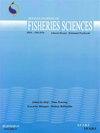Research Article: Determination of freshness quality changes using selective methods: A comparative study for eclipse parrotfish (Scarus russelii) and spangled emperor (Lethrinus nebulosus)
IF 0.6
4区 农林科学
Q3 FISHERIES
引用次数: 0
Abstract
The present study was carried out to determine freshness quality and remaining storage time of eclipse parrotfish and spangled emperor stored in ice on days 0, 2, 3, 5, 7, 9, 12, 15, 19 and 21 using selective methods. A score of 11-12 coincided with the level at which the fish were considered unacceptable by a sensory panel of six experienced assessors. The demerit score of eclipse parrotfish and spangled emperor increased linearly (R2=0.9563 and 0.9624, respectively) with storage time. The limit for acceptability of eclipse parrotfish and spangled emperor stored in ice was 9 and 19 days respectively. Total volatile base nitrogen value (45.87±1.10 mg/100g) for parrotfish stored in refrigerator exceeded limit of acceptability at the time of sensory rejection (9th day) while the value (5.93±0.28 mg/100 g) for spangled emperor was remained below the limit of acceptability after 9 days and increased to 54.96±1.80 mg/100g at the 19th day. The pH for both fishes showed significant (p <0.05) increases during the storage. Total viable count in spangled emperor analyzed were found to be below the acceptability limits (6 log10 cfu/g) by 15 days while maximum level of acceptability of eclipse parrotfish was until 7 days. Shelf-life of both fishes was different. Sensory score, value of TVB-N, pH and TVC provide evidence that the limit for acceptability was 7 days for eclipse parrotfish and 15 days for spangled emperor stored at 0 - 20C.研究论文:用选择性方法测定食鹦嘴鱼(Scarus russelii)和珠光鱼(Lethrinus nebulosus)鲜度变化的比较研究
本研究采用选择性方法测定了食鹦嘴鱼和花皇鱼在第0、2、3、5、7、9、12、15、19和21天的冰冻保鲜品质和剩余贮藏时间。11-12分正好符合由6名经验丰富的评估员组成的感觉小组认为这些鱼不能接受的水平。随着贮藏时间的延长,食鹦嘴鱼和花皇鱼的不合格评分呈线性增加(R2分别为0.9563和0.9624)。月食鹦嘴鱼和珠光鱼的冰封可接受期限分别为9天和19天。冷藏鹦形鱼的总挥发性碱氮值(45.87±1.10 mg/100g)在感官排斥时(第9天)超过了可接受限度,而花皇鱼的总挥发性碱氮值(5.93±0.28 mg/100g)在第9天仍低于可接受限度,在第19天增加到54.96±1.80 mg/100g。贮藏期间,两种鱼的pH值均显著升高(p <0.05)。分析发现,光皇鱼总活菌数低于可接受限度(6 log10 cfu/g) 15天,而食鹦嘴鱼的最高可接受水平为7天。两种鱼的保质期是不同的。感官评分、TVB-N值、pH值和TVC值表明,在0 ~ 20℃条件下,食鹦嘴鱼的可接受时限为7 d,花皇鱼的可接受时限为15 d。
本文章由计算机程序翻译,如有差异,请以英文原文为准。
求助全文
约1分钟内获得全文
求助全文
来源期刊

Iranian Journal of Fisheries Sciences
FISHERIES-
CiteScore
2.30
自引率
11.10%
发文量
0
审稿时长
3 months
期刊介绍:
1- Living various species (contains animals and vegetal species) in various aquatic ecosystems.
2- Health and diseases of aquatic species.
3- Determining the stocks and specific time and location for catching and reliable exploitation for sustainable development.
4- Methods of propagation and culture of high value aquatic resources.
5- Aquatic stock assessment and the methods of restocking the high value species and suggestion for rate, areas and the time for releasing fish and other aquatic organisms fries.
6- Pollutant agents and their effects to the environments of aquatic species.
7- Feed and feeding in aquatic organisms.
8- Fish processing and producing new products.
9- The economic and social aspects of fisheries.
 求助内容:
求助内容: 应助结果提醒方式:
应助结果提醒方式:


